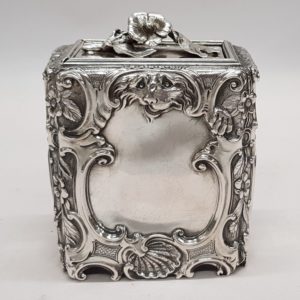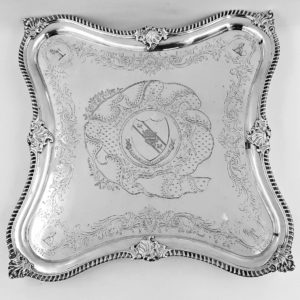Edward Wakelin
Edward Wakelin, apprenticed to John le Sage June 1730, free 1748. By 1747 he had joined the famous George Wickes at Panton Street, entered his first mark (2 sizes) which was almost indistinguishable from the mark of George Wickes, and during the period 1747-1760 Wakelin took virtual charge of the silver side of Wickes’ business. By 1752, Wickes was already making retirement plans although the formal date of the hand over to Wakelin, and his new partner, John Parker I was dated 1760.
Between 1750 and 1760 George Wickes had business associations with Samuel Netherton although they never entered a mark for a partnership. It appears that during this time Netherton took care of the jewellery side and Wakelin managed the silver workshop and used his own mark on the silverware produced.
Wakelin, in partnership with John Parker I, entered a new mark circa 1758-1761 where Parker’s initials appear above Wakelin’s, suggesting that he became the senior partner at this point. John Parker I and Edward Wakelin retired in 1777 and the business was continued by John Wakelin, Edward’s son, and William Taylor.
Edward Wakelin was a man of extraordinary business acumen. He bought into an established business and possessed the ability to ensure its continued success. He employed talented, but mainly anonymous silversmiths at Panton Street, outsourcing what he was unable to make. Two of these highly skilled silversmiths were James Ansill and Stephen Gilbert, former apprentices of George Wickes, who never entered a mark while working for Parker and Wakelin, but in 1780 Stephen Gilbert entered a mark in partnership with Andrew Fogelberg that continued until 1793. It is highly probable that Sebastian and James Crespel learnt their trade under Edward Wakelin and there was a definite financial connection between the Crespels and Wakelin and Parker.
Edward Wakelin
Edward Wakelin, apprenticed to John le Sage June 1730, free 1748. By 1747 he had joined the famous George Wickes at Panton Street, entered his first mark (2 sizes) which was almost indistinguishable from the mark of George Wickes, and during the period 1747-1760 Wakelin took virtual charge of the silver side of Wickes’ business. By 1752, Wickes was already making retirement plans although the formal date of the hand over to Wakelin, and his new partner, John Parker I was dated 1760.
Between 1750 and 1760 George Wickes had business associations with Samuel Netherton although they never entered a mark for a partnership. It appears that during this time Netherton took care of the jewellery side and Wakelin managed the silver workshop and used his own mark on the silverware produced.
Wakelin, in partnership with John Parker I, entered a new mark circa 1758-1761 where Parker’s initials appear above Wakelin’s, suggesting that he became the senior partner at this point. John Parker I and Edward Wakelin retired in 1777 and the business was continued by John Wakelin, Edward’s son, and William Taylor.
Edward Wakelin was a man of extraordinary business acumen. He bought into an established business and possessed the ability to ensure its continued success. He employed talented, but mainly anonymous silversmiths at Panton Street, outsourcing what he was unable to make. Two of these highly skilled silversmiths were James Ansill and Stephen Gilbert, former apprentices of George Wickes, who never entered a mark while working for Parker and Wakelin, but in 1780 Stephen Gilbert entered a mark in partnership with Andrew Fogelberg that continued until 1793. It is highly probable that Sebastian and James Crespel learnt their trade under Edward Wakelin and there was a definite financial connection between the Crespels and Wakelin and Parker.
-


1748
Edward Wakelin
9454 Antique George II Silver Caddy
Sold
A magnificent antique sterling silver tea box with a sliding top and cast silver flower finial. Very heavy cast silver design. The deep relief decoration includes flowers, shells, scrolls and a magnificent lions head and paw. After a Paul de Lamerie design. Weight 462 grams, 14.8 troy ounces. Height 13.5cm. Top 10.2 x6.7cm. London 1748. Maker Edward Wakelin for George Wickes.
-


1755
Edward Wakelin
9859 George II Antique Silver Salver
Sold
Large size and very impressive. A rare antique silver salver, of unusual square waisted form with gadroon borders and shell corners. Heavy gauge silver. The outside centre has a traditional shell and foliate engraved theme with shells and a crest to each corner. Engraved to the centre is a marriage coat of arms with an “escutcheon of pretence”, and the motto “Laudabunt Alii Rhodon” circa 1790. The engraved mantling, of an unfurling ruffle of cloth, is very striking and contemporary to the arms. Weight 2190 grams, 70.4 troy ounces. Height 4.5cm. Width 40cm. London 1755. Maker Edward Wakelin. Sterling silver.